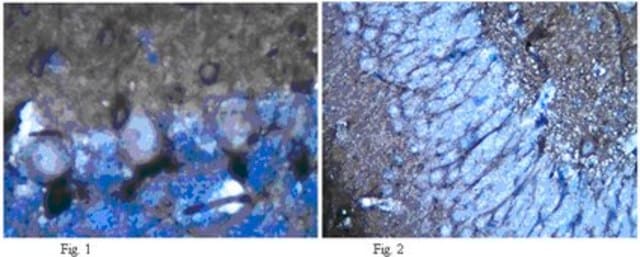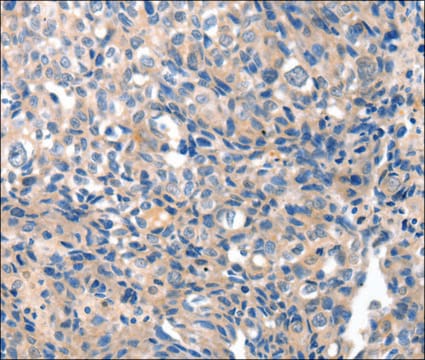MAB5578
Anti-NMDAR2D Antibody
ascites fluid, clone 1G9.39A5, Chemicon®
Autenticatiper visualizzare i prezzi riservati alla tua organizzazione & contrattuali
About This Item
Codice UNSPSC:
12352203
eCl@ss:
32160702
NACRES:
NA.41
Prodotti consigliati
Origine biologica
mouse
Livello qualitativo
Forma dell’anticorpo
ascites fluid
Clone
1G9.39A5, monoclonal
Reattività contro le specie
human, mouse, rat, rabbit
Produttore/marchio commerciale
Chemicon®
tecniche
western blot: suitable
Isotipo
IgG2b
N° accesso NCBI
N° accesso UniProt
Condizioni di spedizione
dry ice
modifica post-traduzionali bersaglio
unmodified
Informazioni sul gene
human ... GRIN2D(2906)
Categorie correlate
Specificità
NMDAR2D, C-terminal. By Western blot the antibody reacts with a weak band at ~145. An additional band at ~75 kDa may be seen depending on sample and antibody concentration used.
Immunogeno
Recombinant protein from rat NMDAR2D.
Applicazioni
Anti-NMDAR2D Antibody detects level of NMDAR2D & has been published & validated for use in WB.
Research Category
Neuroscience
Neuroscience
Research Sub Category
Neurotransmitters & Receptors
Neurotransmitters & Receptors
Western blot: 1:500-1:1,000 on rat brain lysate.
Optimal working dilutions must be determined by end user.
Optimal working dilutions must be determined by end user.
Stato fisico
Liquid.
Stoccaggio e stabilità
Maintain at -20°C in undiluted aliquots for up to 6 months after date of receipt. Avoid repeated freeze/thaw cycles.
Risultati analitici
Control
Rat forebrain or cerebellum.
Rat forebrain or cerebellum.
Note legali
CHEMICON is a registered trademark of Merck KGaA, Darmstadt, Germany
Esclusione di responsabilità
Unless otherwise stated in our catalog or other company documentation accompanying the product(s), our products are intended for research use only and are not to be used for any other purpose, which includes but is not limited to, unauthorized commercial uses, in vitro diagnostic uses, ex vivo or in vivo therapeutic uses or any type of consumption or application to humans or animals.
Codice della classe di stoccaggio
10 - Combustible liquids
Classe di pericolosità dell'acqua (WGK)
WGK 1
Punto d’infiammabilità (°F)
Not applicable
Punto d’infiammabilità (°C)
Not applicable
Certificati d'analisi (COA)
Cerca il Certificati d'analisi (COA) digitando il numero di lotto/batch corrispondente. I numeri di lotto o di batch sono stampati sull'etichetta dei prodotti dopo la parola ‘Lotto’ o ‘Batch’.
Possiedi già questo prodotto?
I documenti relativi ai prodotti acquistati recentemente sono disponibili nell’Archivio dei documenti.
Sharon A Swanger et al.
The Journal of neuroscience : the official journal of the Society for Neuroscience, 35(48), 15971-15983 (2015-12-04)
The GluN2D subunit of the NMDA receptor is prominently expressed in the basal ganglia and associated brainstem nuclei, including the subthalamic nucleus (STN), globus pallidus, striatum, and substantia nigra. However, little is known about how GluN2D-containing NMDA receptors contribute to
Gajanan P Shelkar et al.
Scientific reports, 9(1), 7572-7572 (2019-05-22)
The GluN2C- and GluN2D-containing NMDA receptors are distinct from GluN2A- and GluN2B-containing receptors in many aspects including lower sensitivity to Mg2+ block and lack of desensitization. Recent studies have highlighted the unique contribution of GluN2C and GluN2D subunits in various
H Wang et al.
Neuroscience, 188, 168-181 (2011-05-21)
Untimely activation of nicotinic acetylcholine receptors (nAChRs) by nicotine results in short- and long-term consequences on learning and behavior. In this study, the aim was to determine how prenatal nicotine exposure affects components of glutamatergic signaling in the hippocampus during
Marie A Doyle et al.
Neuropharmacology, 225, 109377-109377 (2022-12-18)
Stress coping strategies represent critical responses to environmental challenges, and active coping has been linked to stress resilience in humans. Understanding the neuroadaptations that support these strategies may provide insights into adaptive and maladaptive stress responses. NMDA receptors (NMDARs) play
Jeremy S Lum et al.
Journal of psychiatry & neuroscience : JPN, 43(2), 102-110 (2018-02-27)
The nucleus accumbens (NAcc) has been implicated in the pathology and treatment of schizophrenia. Recent postmortem evidence suggests a hyperglutamatergic state in the NAcc. With the present study we aimed to explore possible glutamatergic alterations in the NAcc of a
Il team dei nostri ricercatori vanta grande esperienza in tutte le aree della ricerca quali Life Science, scienza dei materiali, sintesi chimica, cromatografia, discipline analitiche, ecc..
Contatta l'Assistenza Tecnica.








